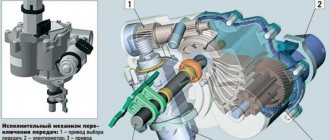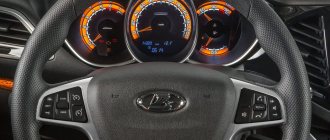— Indication of pressing the brake pedal
— Indication of clutch heating or transmission malfunction (!).
The engine can only be started in neutral position N and with the brake pedal pressed. This is a safety requirement and the engine will not start in any other selector position. If one of these conditions is not met, the failed action symbol will flash:
N or
When turning the ignition key, there may be a delay of 2-3 seconds in starting the engine, this is due to the initialization procedure of the transmission control system.
Movement is possible after moving the selector to position A or M or R with the brake pedal pressed. When you press the accelerator pedal, the clutch is engaged and the car begins to move. If the accelerator pedal is not pressed, the car does not move, but can roll freely, despite the driving mode and gear being engaged. The AMT transmission does not have a creep mode by design.
If, after starting the engine, you move the selector to position M, 1st gear will engage. Then you can change gears manually. Shifting upshifts in M mode in normal operating modes is carried out only by the driver sequentially 1-2-3-4-5
and in reverse order. Downshifting is carried out automatically based on the reduction in speed in both A and M modes, this prevents the engine from stalling when the car is stopped. M mode allows for combined braking of the car with the service brake and the engine by sequentially shifting gears to lower ones. Be careful, when starting and driving in M mode in first gear, you can reach maximum engine speeds; this was done specifically for the purpose of driving up steep and long climbs, using only first gear. When maximum engine speed is reached in second and all other gears, the system will shift to an upshift to prevent engine damage.
In all driving modes, delays are felt due to the operation of the gearbox synchronization system during the shift process. Mode A is tuned for the most comfortable driving style, and the delays are slightly longer than in mode M.
Modes A and M have a kick-down function for sharp acceleration; it is activated depending on the intensity of pressing the accelerator pedal.
Press the accelerator pedal firmly all the way (until the resistance of the pedal moves is overcome), and, depending on the speed and engine speed, the automatic switches to the optimal lower gear. Shifting to the next higher gear will occur immediately after reaching the maximum engine speed corresponding to this gear.
It must be taken into account that when the kick-down device is activated while driving on smooth and slippery surfaces, the drive wheels may slip - there is a risk of skidding!
While driving, it is possible to move the selector lever from position A to position M and back. If you need to select an independent switching mode, or, while driving in mode A, you first need to switch to a lower gear (for example, when overtaking and entering the oncoming lane), you can turn on mode M, make a maneuver and then return back to mode A , the system will switch on the gear corresponding to the speed.
If the lever is improperly switched from position A to position R while driving, the system will block the engagement of reverse gear. In this case, the R mode symbol indicator will flash, indicating to the driver that this switching is not possible.
To eliminate cases of transmission breakdown, the system in all cases will not allow you to engage a gear that does not correspond to the speed.
If it is necessary to rock the car, for example, when slipping, it is possible to switch between modes R - A and vice versa through N, but without delay in N and without pressing the brake pedal, provided that the speed does not exceed 3 km/h. At speeds above 3 km/h, switching from A to R or from R to A is not possible. To successfully engage reverse gear, in some cases it is necessary to wait a pause for the system to successfully work out the function of ensuring engagement of reverse gear.
You can turn off the ignition in any selector position. The AMT controller de-energizes the actuators after completing all actions after 60 seconds, during which time it remembers the latest current information on the position of the actuators and engages (closes) the clutch. However, in the case when the ignition is turned off and for about 5 seconds, while the brake pedal is still pressed, the selector is moved, for example, from position N to positions A, M/R, then in this case the AMT controller will engage first/reverse gear and Only then will it turn off. This is done in order to
the driver still had the opportunity to immobilize the car when it was parked without turning on the ignition again.
In position N, with the ignition off, the car can roll and can be towed; in other selector positions, the car will remain in the selected mode (R - in reverse gear, A and M - in first gear) and the clutch is closed. In any case, depending on the slope, it is necessary to prevent spontaneous rolling of the car using the hand brake.
When entering steep slopes at low speeds (such as parking lots, overpasses), it should be noted that when the engine speed decreases below the minimum (650 min-1), the clutch will disengage automatically to avoid engine stalling. On a slope, this may cause the vehicle to roll down. In this case, it is necessary to ensure movement with engine speeds exceeding the minimum.
To ensure safety when driving a car with a trailer in difficult road conditions (mountainous, dirt and snowy roads, or roads with damaged surfaces), use a trailer weighing no more than 450 kg (in normal driving conditions, the total weight of a trailer equipped with brakes is no more than 900 kg) and It is recommended to switch to “M” mode.
When driving on roads with slippery surfaces (wet, dirty, icy, etc.) in mode “A”, it is recommended to smoothly control the accelerator pedal to prevent wheel slipping.
When driving on descents in mountainous conditions in automatic mode A, after pressing the service brake once, the engine braking mode is activated, while
a lower gear is engaged, except for shifting from
2nd gear to 1st (for safety reasons on slippery surfaces). This allows for safer driving in these conditions. An upshift will occur after the vehicle has leveled off on a slope and the accelerator pedal has been pressed.
To facilitate the process of starting off on slopes, the anti-rollback system is activated within 2 seconds, holding the car in place and preventing it from rolling down the slope.
Gearbox robot
The Lada Vesta car uses a robot as an automatic transmission. It is really difficult to say why the engineers of the automobile concern chose this particular option, because there are now a large number of torque converters from various manufacturers on the market.
The concern's designers took the VAZ gearbox as the basis for the AMT (robot), in contrast to the mechanical transmission of this model, which uses a unit from Renault. In general, this is a conventional mechanics on which an electronic control unit has been installed. The use of this box is determined more by price than by other factors. The AMT gear lever does not have a parking position, only reverse gear, neutral gear, automatic mode (something like drive) and manual shifting. The interesting thing is that when changing gears manually, you cannot engage reverse or go into neutral. Forward gears are used.
Via phone
- For an Android smartphone, download and install the ECU Tweaker application. We copy the ecu.zip archive to the root of the internal or external memory without unpacking it.
- Connect the ELM327 V1.5 adapter to the OBDII port of the car.
- Turn on the ignition.
- Launch the “ECU Tweaker” application on your smartphone
- In the search, select “BM LADA”
- Then "Automatic Transmission"
- Then "BVR_On_CAN_x52_JS3_v2.4"
- Then "After sales"
- Then "Diagnostic"
- Then the "Wrench"
- Go back and select “Learnings information”
- Go back and select “Learnings Procedures”
- Complete the training (see “Training Procedure” above)
If after AMT adaptation the engine does not start
. It is possible that the last learning procedure was completed incorrectly and an error was stored in the memory of the electronic unit. It is necessary to perform diagnostics, reset errors, and perform adaptation again.
You can also perform AMT adaptation using OpenDiag Pro or Scanmatic software (see an example of such adaptation). Both programs are paid.
Possible problems with the robot and the advantages of the box.
The negative attitude of most people towards the AMT transmission is very justified, because many automakers who have used a robotic gearbox in their models can receive a whole list of complaints from car owners. This includes jerking at the most inopportune moment, howling of the transmission with subsequent breakdown and a call to the service center. Transmission manufacturers such as Opel, Ford, Toyota and Honda have tarnished their reputation. European models were slightly better, and the most negative reviews about the robot gearbox were received by the Japanese.
At the same time, with a quiet ride, proper maintenance and adaptation of the AMT to your driving style, the cars were possible to use. At the gearbox of the Lada Vesta robot, a ZF control unit is used, which is well known when using manual transmission automation. At the same time, this is not the best option; Opel and Ford also used gearbox blocks from this manufacturer.
Vesta comes with a robotic gearbox with better and more reliable switching algorithms, due to which the car drives really well.
Pros of a robotic box:
- In order to start moving, you need to move the box to position “A” (automatic mode), thanks to which you avoid overheating of the clutch, unlike, for example, DSG boxes.
- With proper driving and maintenance, the unit will last a very long time, due to a more accurate switching algorithm than a manual gearbox.
- The hard start program and incline assist will help you climb uphill with a loaded car.
- Smooth switching during quiet driving without jerks or joints.
Cons of AMT:
- If you are a fan of active driving, we do not recommend buying a car with a robotic gearbox, since the average gear shift time, as stated by the manufacturer, is about 2 seconds.
- Gear changes during acceleration are accompanied by some pauses.
- If the box is not used correctly, repairs are frequent and not very cheap.
- There are no paddle shifters, instead you have to pull the gearbox lever.
GQ7Q2455
Guess the maneuver
Unlike a hydromechanical gearbox, movement without warming up immediately after starting the engine at low temperatures is not so harmful for the robot. The AMT is also lighter and more economical than a traditional automatic. And significantly cheaper. You have to pay for these advantages with ease of traction control and comfort in transient conditions. And in the case of a single-disk robot, as on Vesta, also the speed of switching. For example, in gearboxes with two clutches (for example, DSG from Volkswagen), where different clutches are responsible for even and odd gears, gear changes occur almost instantly, without interrupting the power flow. After all, to do this, it is enough to open one clutch and close another with a pre-selected gear. And on Vesta, the automatic system acts like a driver when driving with a manual transmission: it opens the clutch discs, then changes gears and closes the clutch again. It takes noticeably longer to complete the circle.
- If you have already driven a Kalina or Priora with a similar AMT, forget those feelings. For Vesta, the box was thoroughly reconfigured and equipped with an original control unit. Shifts have become smoother... and longer (1.7 s versus 1.43 s on Kalina). Loss of traction for such a period of time in a bustling stream is fraught, if not with an emergency, then at least with the urging horns of the drivers whom you have detained. However, you can select the manual control mode and work proactively, tuning the desired gear in advance. Or order a sticker with the inscription on the rear window Manual transmission
in a triangle.
Reviews of the Lada Vesta robot gearbox
We have collected real reviews from people and present them to your attention:
Overall the gearbox is not bad. Sometimes the robot twitches, maybe it’s not used to it yet. Mileage 7800 km.
I didn't like the gearbox. I borrowed it from a friend, drove it for a week, but it didn’t work. I bought myself a mechanic and I don’t know what the problem is, I’m happy with it.
A good box if you don't constantly sink it into the floor. I finally got used to my driving style after 3000 km. If you are a Schumacher, then this is not for you.
Generally speaking, the box is a robot for everyone. It all depends on your driving style. In some moments it is inferior to torque converters, due to their reliability and simpler design, but with proper maintenance and operation it will not leave you indifferent. The choice is yours. We wish you good luck in purchasing a car.
Quite recently, a new product on the domestic market went on sale - the Lada Vesta with an automated manual transmission. Reviews from owners about the robot on Vesta vary greatly: some swear and say that they will never drive such a car again, while others, on the contrary, are happy with the purchase. In this article we will figure out what AMT is on a Lada and whether it is worth buying a car with an unusual configuration.
What is the difference between AMT and automatic transmission?
How does the robot on the Vesta work and how does it differ from a car with an automatic transmission? In terms of structure, it is designed exactly the same as a manual transmission. A robotic one has little in common with an automatic transmission. If in a conventional automatic transmission the torque is transmitted from the engine to the wheels by a torque converter, then in a robotic gearbox the torque is transmitted through gears. The robot was made on the basis of a VAZ mechanical transmission. The AMT consists of the mechanical box itself, the clutch and the electronic unit that controls it.
When developing the new box, engineers from the Tolyatti plant used the experience of foreign manufacturers. And the clutch included in the AMT package is made in France. The part is protected by a wear compensation function that prevents premature failure. There have not yet been any cases of warranty claim registered.
Many people are perplexed: why can’t an automatic transmission be developed on a Russian basis, because so far no domestic car has such an improvement. The answer is simple: the development of automatic transmissions is possible already on the existing base, which does not yet exist in Russia. And production based on foreign developments will significantly increase the final cost of the car. For comparison, using an automatic machine will cost approximately twice as much as a robot.
GQ7Q0286
And the clearance varies. On a three-pedal Vesta, from the asphalt to the drain plug of the engine oil pan is 190 mm. It's the same distance to the bottom of the box. The units of the robotic Vesta are suspended a little higher: there are 195 mm to the engine oil pan plug, and 200 mm from the robot to the ground. In both cases, the engine compartment is covered with a steel mudguard, the clearance under which is 185 mm.
Of course, we remember that in the comparative test of Vesta with its competitors, we measured 190 mm under protection, but on that pre-production car, tires measuring 205/55 R16 were installed. Serial Vestas are shod with different tires - 195/55 R16. Hence the difference in results.
The curb weight was also compared. Vesta with the robot turned out to be 20 kg lighter, and there are several reasons for this. The AMT gearbox is 2.2 kg lighter than the French manual and requires a little less oil. Like the power unit paired with a manual gearbox: it has a different oil pan, and the lubrication system holds 1.2 liters less oil. In addition, the mechanical Vesta has a heavier multimedia unit with navigation and a rear view camera included, while the robotic car has a simpler radio. And for some reason there was no protection for the rear wheel arches. Although both cars have similar Lux trim levels, with the exception of a few options. Just like that, little by little, I gained 20 kg.
Instructions for using a machine with AMT
How to use the new gearbox? Reviews from owners of the Lada Vesta 1.8 robot indicate that you still need to learn how to use the AMT. The car's on-board computer displays information that helps monitor the operation of the transmission:
- Mode (manual/automatic).
- Active transmission.
- Brake pedal activity.
So how do you start a Lada Vesta with AMT? To do this you need to follow a number of simple steps:
- Press the brake pedal.
- Move the shift lever to the neutral position.
- Start the car.
It is important to note that any changes in the position of the selector can only be made while the brake pedal is pressed. If you want to park the car, the manufacturer recommends turning off the engine, leaving the handle in the manual or automatic mode position. Very often, novice drivers have a question: what to do if you get stuck in a traffic jam on a slope? To prevent the car from rolling back, it is permissible to lightly press the gas pedal. When driving on a slope, the robot selects first or second gear so that the engine does not stall.
Another useful feature of LADA with AMT is that it can be started from a pusher. Rope launch is activated at speeds of 7 km/h and above. The car also has a transmission brake function. When rolling down an inclined surface, it is permissible to use the brake pedal for more effective braking. All these useful modes make operating the Lada Vesta with AMT convenient and comfortable.
How to perform AMT diagnostics (error reset)
- Turn on the ignition and connect to the car using the ELM327 adapter and DDT4ALL software.
- Select in the upper left window XGA-XRAY - AT - BVR_On_CAN_x52_J53_v2.4
- In the middle window [AT] BVR_On_CAN_x52_J53_v2.4
- In the lower left After sales - Diagnostic
. - We make sure that the two selected windows have non-zero values.
- Click on the “heart”
in the top menu, remember or write down the errors, then erase the errors.
Test drive by specialists
What do professionals say about the robot box in Lada Vesta? You can find many reviews of the new product on the Internet. Most note the slow response of the box during acceleration. Some call the driving style of the Lada Vesta robot a style for summer residents. Slow acceleration of the car contributes not only to fuel economy, but also to passive safety. No matter how hard you try to squeeze out maximum speed in order to overtake three or two cars, it is unlikely that you will be able to do it quickly. True, the car behaves a little more cheerfully in manual mode, in which it is more realistic to squeeze the maximum out of the 1.8-liter engine. But, if you get used to this driving style, you begin to notice the advantages: the parts are made well and do not fail for a long time. Compared to manual and automatic transmissions, AMT provides significant fuel savings.
After the driver presses on the gas and the engine picks up speed, the transmission begins to upshift. The problem is that the robot on the Vesta cannot do this without reducing the thrust. The switching time fluctuates around 2 seconds, which can be quite annoying at first. But you won’t feel any jerks, the clutch is as smooth and comfortable as possible. In the reviews of the owners of the Lada Vesta robot in 2022, you can find a comic name for this driving style - driving a Chinese dummy. Due to the excessively sharp speed difference between first and second gear, Vesta drivers and passengers nod due to uneven acceleration.
But, despite various points of view, most reviews about the Vesta 1.8 robot indicate that the introduction of an automated manual transmission was a big leap forward for the domestic manufacturer. Car enthusiasts hope that the improvements will not end there; Lada engineers will properly finalize the box, and it will be a pleasure to drive. By the way, on the official website of the automaker there is already a survey on what users would like to change in the AMT box. So you should be patient - improvements are just around the corner.
Signs of clutch failure
The occurrence of malfunctions in the Vesta clutch mechanism is most often associated with improper operation (inexperience of the driver, aggressive driving style), an initial defect in the part, or breakdown of other components interacting with it. Of course, you will immediately notice problems with the clutch - the car will begin to behave differently:
- Gears are difficult to shift/do not work at all;
- Pedal too soft/hard;
- The car jerks;
- The device is activated in the upper position of the pedal.
There can be many reasons for this behavior of Vesta, and not all of them are related to the intermediate part between the internal combustion engine and the gearbox. Often the problem comes from the fluid system. There may be a malfunction of the brake master cylinder, clutch slave cylinder, damaged hoses, a simply low DOT4 level or an air lock. Such problems (especially problems with the cylinder of the unit) have exactly the same effect as the failure of the entire unit. The clutch consists of a housing cast together with the drive/pressure plate (basket) and the driven disc. The release bearing of the Lada Vesta acts on the petals of the basket, which, in turn, with the help of damper springs, press the inner disk away from the flywheel - the clutch opens. The bearing moves either under the influence of the hydraulic pedal drive (manually) - manual gearbox, or from the actuator (automatically) - manual gearbox. These parts can fail: more often - the release mechanism, less often - the basket body. Let's take a closer look at the most common “breakdowns”.
Robot on Vesta: reviews
Drivers online are furiously discussing Lada's innovation. Both experienced drivers and beginners who have previously driven only a manual transmission become participants in the debate. Reviews from owners of a Lada Vesta with a robot indicate that not everyone has an unambiguous perception of this new product. On the one hand, there are no those who are 100% satisfied with the AMT of the domestic manufacturer. On the other hand, is it worth being so critical of the first attempts to automate machine control?
Let's take a closer look. The main thing when buying a Lada Vesta with AMT is to clearly understand who such a car is intended for. First of all, this is a car for a quiet and comfortable ride around the city, and not for racing. Vesta with a robotic gearbox is ideal for city traffic jams. If you are tired of manual gear shifting, but foreign cars with an automatic transmission are not yet available to you, then the new Lada will be an excellent option.
GQ7Q0748
Another thing is interesting: for 100 manual transmission shifts, the AMT indicator changed the number of the selected gear 117 and 122 times, depending on the driver. The difference is due to the fact that during decelerations the robot sequentially switches gears until the car comes to a complete stop. However, you don’t feel the switching itself, and the tachometer needle remains stationary until the driver touches the accelerator pedal. But if you go “down” in manual AMT control mode, you can brake with the engine.
Trophy
Having driven the Vestas onto the lift, we discovered other design differences. The engine, paired with French mechanics, has a cast sump, which is attached to the cylinder block and to the clutch housing. This made it possible to increase the rigidity of the entire structure. And the robot got a standard VAZ stamped pan, not connected to the clutch housing.
The nuances of driving the Vesta robot
As with all cars, when driving a Lada robot, there are some nuances that should be taken into account when purchasing. They can be understood most clearly if you read the reviews about the robot on Vesta. For example, the gearbox is sometimes tricky when changing gears. If you are driving in second gear, slowly picking up speed, the robot may misunderstand you and shift to first gear instead of third. This often happens during not very dynamic acceleration.
If you need a faster start, there is a little trick. Usually, when driving on the highway, the robot engages fifth gear. If you press the gas pedal to the floor, the car engages third gear, after which the speed immediately increases. This allows you to overtake on high-speed sections of the road. After completing the maneuver, just release the pedal to its normal state, and the AMT will switch back to 5th gear.
As we have already said, a processor is inserted into the robot on the Lada, which reads the behavior and driving style of the driver and adapts to it. If you want the most dynamic acceleration without jerking, then you can try the following driving style:
- Accelerate without releasing the gas pedal. The robot itself will select the right moment to shift from first gear to second, and then to third. But be prepared for a slight jerk between shifts.
- Once your car reaches a speed of 40 km/h, release the gas pedal slightly. At this moment, the car will smoothly shift gears.
- The same action must be repeated at a speed of about 60-80 if you are going to go even faster.
- If at speed 4 you do not press the gas pedal to the floor, then, most likely, AMT will immediately set speed 5, at which dynamic acceleration is impossible.
- When driving uphill, the robot itself slows down if it becomes difficult for the engine to hold the current gear. For beginners, this nuance is especially good: now your car will definitely not stall while climbing a slope.
You still need to get used to driving a manual automatic transmission, but the convenience and reasonable cost of the AMT completely hides all its shortcomings.
When should adaptation be made?
You have a pre-production car, and you need to update the settings to more recent and correct ones.
The fact remains that the first cars turned out to be a little damp and there’s nowhere without it, but fortunately AvtoVAZ quickly solves the problem, as it has already done with bushings and stabilizer struts, with the clutch.
It turned out that the Turkish Valeo clutch, which was installed on the first cars, is not suitable for the weight of the car. As a result, the owners of the first West felt the clutch slipping, felt that the car was moving poorly and needed to increase the speed. When replacing the clutch with a new one, adaptation is carried out.
AvtoVAZ recommends adapting the robot’s clutch as it wears out, i.e. every 15 t.km for correct and resourceful operation.
What configuration does the AMT come with?
Lada Vesta with an automated manual transmission is available only in luxury configuration. When purchasing this assembly, you can also purchase a manual transmission, which is standard. But for the robot you will have to pay about 25,000 rubles.
Considering that the price for a Lada Vesta in the maximum configuration exceeds 600 thousand, a reasonable question arises: is the game worth the candle? What advantages and disadvantages can be found in such a supplement?
Advantages and disadvantages of the robot on Vesta
Let's start with the advantages. According to reviews of the robot on Vesta, the machine has the following undeniable advantages:
- Equipped with the “Slope Start Assistant” program – even if you park or get stuck in a traffic jam on a slope, this option will help you avoid rolling back when starting. The gearbox increases speed at the start, the clutch becomes stiffer.
- Increased clutch life - thanks to the soft and smooth operation of the AMT, the service life of the part will be long even with careless driving. The shift box is protected against accidental pressing of the lever: if you start shifting it chaotically, the car simply will not react.
- AMT is adaptive and has 26 behavior patterns that it selects depending on the driver’s behavior. How it works? The program reads how the driver operates the gas pedal and, depending on this, switches the clutch at the right moment.
- Fuel economy is hard to believe, but the robot on the Lada is really more economical than a manual or automatic transmission. Thanks to smooth switching, you can use several times less gasoline.
- AMT consumes less oil than manual transmission - also a significant factor in favor of choosing a new configuration.
Reviews of the robot box on Vesta also show the disadvantages of an automated manual box:
- The absence of a parking mode makes parking more difficult; when parking, it is better to leave the control lever in manual or automatic mode to avoid rolling back.
- Gear changes are jerky - between 1st and 2nd gears there is a decrease in speed, which can noticeably slow down the car.
- Slow acceleration - a car with AMT takes a few seconds longer to pick up speed than a car with a manual transmission.
- The inconvenience of the manual mode is that the gearbox is not designed very well, and this makes manual driving of the car less convenient.
Which is better to choose manual or AMT?
The choice between a manual transmission and AMT should be made with a cool head, having calculated all the pros and cons in advance. On the Internet you can find many good reviews about the mechanics or robot of the Lada Vesta. But most drivers opt for an automated manual transmission. It is much more convenient and economical to use. But lovers of classics and conservatives still prefer the usual mechanics. You can only understand whether a car with AMT is suitable for you or not by trying it in action.











